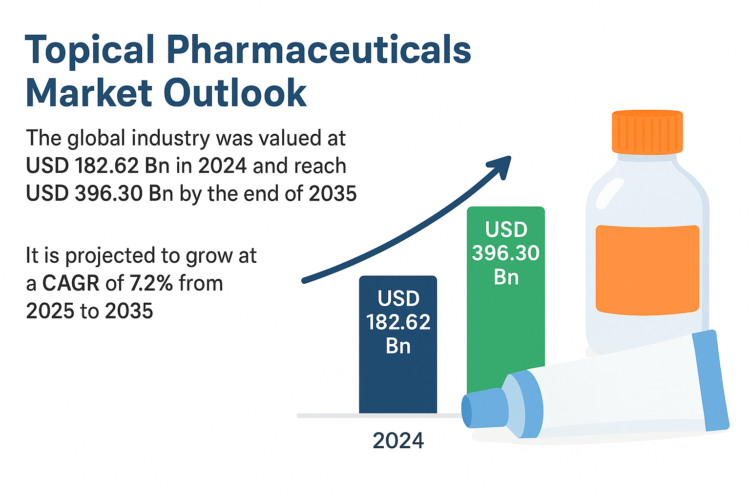The global topical pharmaceuticals market was valued at USD 182.62 billion in 2024 and is projected to reach USD 396.30 billion by 2035, growing at a CAGR of 7.2% from 2025 to 2035. The market growth is driven by the rising prevalence of skin diseases, increasing demand for non-invasive drug delivery methods, and advancements in formulation technologies. Additionally, the growing use of topical treatments for pain management, wound healing, and cosmetic applications further supports market expansion over the forecast period.
The global topical pharmaceutical market is witnessing consistent growth owing to the increasing incidence rate of skin disorders, an aging population, and developments in drug delivery systems.
Topical products in the form of creams, ointments, gels, and lotions provide localized therapy with fewer systemic side effects and are hence in high demand in diseases like eczema, psoriasis, acne, and infections.
Obtain a sample copy of the Topical Pharmaceuticals Market Intelligence Study, published by Transparency Market Research, for detailed insights.
Market Segmentation
The market is segmented based on various factors, providing a detailed view of its diverse landscape:
- By Service Type (As per related industry data):
- Contract Manufacturing (Dominant): Outsourcing manufacturing processes remains the largest segment, offering pharmaceutical companies cost-efficiency and flexibility.
- Contract Development: Expected to grow lucratively, driven by the need for specialized formulation development services.
- By Sourcing Type (Implicit in manufacturing):
- In-house: Manufacturing performed within the company’s own facilities.
- Outsourced (CDMOs/CMOs): Dominates, leveraging the expertise and capacity of Contract Development and Manufacturing Organizations (CDMOs) for both small and large-scale production.
- By Application:
- Dermatological Treatments (Leading Segment): Dominates the market, encompassing conditions like eczema, psoriasis, acne, and fungal infections.
- Wound Healing & Burn Care: Growing segment supported by an increasing number of burn injuries and the demand for advanced topical antimicrobials and dressings.
- Anti-inflammatory/Pain Management: Significant and fast-growing segment, utilizing topical analgesics for musculoskeletal and neuropathic pain.
- Others: Includes ophthalmology, hormone replacement therapy, and nasal drug delivery.
- By Industry Vertical (End-User):
- Hospitals & Clinics (Dominant End-User): Remains a major segment due to high utilization in prescription-based treatments and specialty care.
- Home Care Settings (Fastest-Growing): Surging demand for self-administration of medication, especially for chronic conditions and due to convenience, is driving this segment.
- Burn Centers: Specialized high-growth segment, reliant on high-volume use of topical drugs.
- By Region:
- North America: Historically the dominant region due to high healthcare expenditure, advanced dermatological infrastructure, and the presence of major pharmaceutical companies.11 The U.S. remains the largest market within this region.
- Asia Pacific (Fastest-Growing Region): Poised for the fastest CAGR due to a vast patient pool, rising disposable incomes, improving healthcare infrastructure, and a growing focus on cost-effective drug production in countries like China and India.
Market Drivers and Challenges
🚀 Market Drivers
- Rising Prevalence of Skin Disorders: The increasing global incidence of chronic dermatological conditions like eczema, psoriasis, and acne directly fuels the demand for topical treatments.
- Advancements in Drug Delivery Systems: Innovations such as nano-formulations, liposomal gels, hydrogels, and microneedle patches are improving drug absorption, permeability, and targeted delivery.
- Patient Preference for Non-Invasive Treatments: The non-invasive nature, ease of application, and reduced systemic side effects of topical drugs make them highly popular for both acute and chronic therapies.
- Growing Geriatric Population: An aging population experiences a higher incidence of dermatological, joint, and chronic pain conditions, increasing the need for convenient, local-acting pain relief and skincare.
🛑 Market Challenges
- Skin Barrier Limitations: The skin’s natural barrier function (stratum corneum) limits the effective penetration of many high molecular weight or poorly lipid-soluble active pharmaceutical ingredients (APIs).
- Adverse Skin Reactions: Ingredients in certain topical formulations can cause irritation, contact dermatitis, or allergic reactions, leading to patient non-adherence.
- Stringent Regulatory Approvals: The process for approving new topical formulations, particularly generics, can be prolonged due to requirements for demonstrating bioequivalence and safety.
Market Trends and Future Outlook
✨ Key Market Trends
- Personalized Medicine: The development of customized topical formulations based on patient-specific factors like genetics, skin microbiome, and lifestyle data is a major emerging trend.
- Combination Formulations: An increasing number of products are combining multiple active agents (e.g., anti-inflammatory, antibacterial, and antifungal) for enhanced synergistic efficacy.
- Sustainable Packaging: Driven by environmental consciousness, there is a growing trend toward eco-friendly packaging, including biodegradable materials, airless pumps, and refillable systems.
- Digital Health Integration: Integration with digital platforms, such as sensor-equipped patches that monitor adherence and deliver real-time data to clinicians, is enhancing treatment management.
🔮 Future Outlook
The future of the topical pharmaceuticals market is highly promising, with innovation focused on overcoming the skin barrier challenge. The convergence of advanced materials science, biotechnology, and drug delivery will lead to the commercialization of new product categories, such as topical biologics and gene therapies. The growth in home care settings, accelerated by telehealth, will further cement topical pharmaceuticals as a cornerstone of patient-centric care.
Key Market Study Points
| Study Point | Description |
| Formulation Dominance | Semi-solid formulations (creams, ointments, gels) currently hold the largest market share due to versatility and widespread use in dermatology. |
| Dermal vs. Transdermal | While dermal (local) treatments dominate by volume, transdermal delivery (systemic) continues to be a high-value focus for chronic pain and hormonal therapies. |
| R&D Focus | Significant R&D is directed toward penetration enhancers and advanced delivery systems (microneedles, nanoemulsions) to improve API bioavailability. |
| OTC Portfolio Expansion | Pharmaceutical companies are expanding their Over-The-Counter (OTC) topical portfolios to capitalize on the increasing self-care trend and address consumer demand for aesthetic and wellness products. |
Competitive Landscape and Recent Developments
🤝 Competitive Landscape
The market is competitive, featuring a mix of large multinational pharmaceutical companies, specialized dermatology firms, and innovative biotechnology start-ups. Key strategies include R&D investment in novel drug delivery platforms, strategic mergers and acquisitions (M&A), and geographical expansion, particularly into the high-growth Asia Pacific region.
Buy this Premium Research Report: https://www.transparencymarketresearch.com/checkout.php?rep_id=86661<ype=S
📅 Recent Developments
- New Product Approvals: The market saw the approval and launch of novel topical treatments for major conditions, such as non-steroidal topical creams for plaque psoriasis and advanced transdermal patches for breakthrough cancer pain.
- Strategic Acquisitions (Example from similar trends): Major pharmaceutical companies have been acquiring smaller biotech firms with promising pipelines in immunology and dermatology to gain access to innovative topical therapies like monoclonal antibodies in late-stage clinical trials.
- Manufacturing Expansion: Investments by CDMOs, for instance, to expand capacity for semi-solid and liquid medication manufacture, indicating confidence in the sustained market growth.
- Focus on Compounded Drugs: The compounded topical drugs market is growing, driven by the demand for highly individualized treatment solutions for pain management and dermatology.
About Transparency Market Research
Transparency Market Research, a global market research company registered at Wilmington, Delaware, United States, provides custom research and consulting services. Our exclusive blend of quantitative forecasting and trends analysis provides forward-looking insights for thousands of decision makers. Our experienced team of Analysts, Researchers, and Consultants use proprietary data sources and various tools & techniques to gather and analyses information.
Our data repository is continuously updated and revised by a team of research experts, so that it always reflects the latest trends and information. With a broad research and analysis capability, Transparency Market Research employs rigorous primary and secondary research techniques in developing distinctive data sets and research material for business reports.
Contact:
Transparency Market Research Inc.
CORPORATE HEADQUARTER DOWNTOWN,
1000 N. West Street,
Suite 1200, Wilmington, Delaware 19801 USA
Tel: +1-518-618-1030
USA – Canada Toll Free: 866-552-3453
Website: https://www.transparencymarketresearch.com
Email: sales@transparencymarketresearch.com















